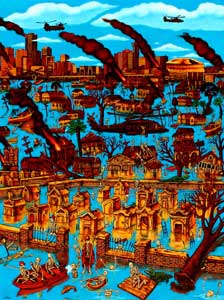No Bones About It
Michael Willmon sees his fellow New Orleans artists at home in the afterlife
by Douglas Maccash, The Times-Picayune
When New Orleans’ post-Katrina Latin-American population eventually revs up its celebration of the Day of the Dead, I guarantee the rest of us will be dressing up as skeletons, sucking on sugar skulls and picnicking in the cemeteries right beside them.
In this city, the living are already all mixed up with the dearly departed. Take our

Standing in for flesh and blood humans, Michael Willmon's skeleton characters struggle to survive in ''The Great Katrina Flood.'' Imagine how Willmon might invision Jazzfest.
architecture, our music, our cuisine, our beloved Ann Rice novels: They’re all ghost stories, in a way. Take our cemeteries: We don’t bury people above ground because of the high water table; we bury them above ground because we want to keep them around.
Nobody understands our fatalistic instincts better than artist Michael Willmon, whose devilish exhibit “Heaven and Hell” at Arthur Roger Gallery, is this month’s show not to miss.
For more than a decade, Willmon has been painting comical cemetery scenes with skeletons scampering around doing pretty much everything they did before they became skeletons. Like the rest of us, Willmon’s skeletons had a rough time during and after the Katrina floods. In a trio of new paintings, we find them dangling from helicopters, clinging to roofs, rowing small boats, escaping alligators, angling in the floodwaters for skeletal fish and demolishing houses with backhoes.
Willmon said his skeletal obsession was inspired in part by the 16th century Flemish painter Bruegel’s “Triumph of Death,” in which “the skeletons are hustling all the people into hell and massacring them.” Two years ago, he traded a painting for a full-sized plastic skeleton, which, one might assume, keeps him company while he’s pouring over his collection of horror magazines.
In the past, Willmon’s dead folks have mostly been anonymous. But no more. In “Heaven and Hell” he gives us a suite of New Orleans artists who’ve gone to their rewards. Moody landscapist Alexander Drysdale floats toward the clouds among a squadron of angels and pelicans. Wildlife watercolorist Walter Anderson paddles his tiny boat in a glorious Technicolor sea. The meticulous abstractionist Robert Gordy hovers in a violet nirvana, beside giant tubes of acrylic paint. And the curmudgeonly surrealist Noel Rockmore is chained to the floor of fire and brimstone studio somewhere south of heaven.
“Rockmore, I stuck him in hell,” Willmon said, explaining that he saw a photo of the late artist in which he looked so sad, “I thought he was in a hell of his own.”
Since 1969 Baton Rouge born Willmon, 56, has lived in New Orleans, which he affectionately describes as a “a very decayed Southern city.” Before that, as a teenager, he spent years in Caracas Venezuela, owing to his father’s job in the oil industry. He believes the Day of the Dead celebrations he saw there may have helped prepare him for his macabre artistic path.
Sometime back I suggested that Willmon would be the perfect artist to do a Jazzfest poster. It’s never been truer.
As you wander “Heaven and Hell” imagine the all-skeleton Jazzfest scene or the refreshingly satiric musician portrait he could create if he were left alone to express the city’s gloriously grim gestalt. Being left alone is the key. In the gallery back room is an early version of this year’s Jerry Lee Lewis Jazzfest poster by Francis X. Pavy — a much quirkier, much cooler, much more Pavy version than the silky, homogenized, corporate compromise that became this year’s poster.
